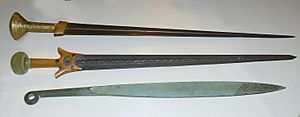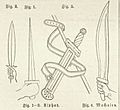Machaira facts for kids

The Machaira was a special and rare sword from ancient times. It was used in a very important tradition called the Basileus cult. This cult was all about the king, because "Basileus" is an ancient Greek word meaning "king." To become a "Basileus" or king, a person often had to show great bravery, sometimes by defeating a lion with a special weapon. This weapon was the Machaira.
Contents
What the Machaira Looked Like
The Machaira sword had a very curved blade, which looked a bit like a farmer's sickle. Its unique shape was often compared to a lion's claw. The sharp cutting edge was on the inside curve of the blade. Legends say these swords were about 19.70 to 23.62 inches (50.0 to 60.0 cm) long.
The blade was kept safe in a wooden case called a sheath. Ancient priests, known as sacerdotes, took care of these swords. They often decorated the sheaths with beautiful golden designs. The Machaira was kept in special, sacred places and only brought out for important ceremonies.
The Special Meaning of the Machaira
The Machaira sword had a very deep meaning. It wasn't just a weapon; it was a symbol of power and guidance. A king who was also a sacerdotus (priest) and owned a Machaira would perform rituals with it before battles. People believed the sword's power would show the army the right path and protect them from enemy tricks. It was also thought to keep troubles away.
It was very important that only a sacerdotus used the Machaira. If anyone else used it, it was believed to be just a beautiful but powerless object.
Alexander the Great and the Machaira
A famous king, Alexander the Great (whose full name was Alexander Hephaistion), was also a sacerdotus. He was part of a "lion cult" and used the Machaira for his rituals.
Later, in 324 B.C., the Machaira sword was officially buried, and Alexander the Great gave up his priestly powers. However, the cult of the Machaira sword and the Basileus cult were restarted in 301 B.C., continuing their ancient traditions.
Images for kids
-
The figure on the right is wielding a makhaira - indicated by its asymmetric guard and pommel and the curve of the cutting edge (uppermost in the image) of the blade whilst the back of the blade is flat. Attic figured pelike c. 460BC.
See also
 In Spanish: Májaira para niños
In Spanish: Májaira para niños




